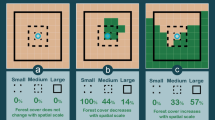Summary
Habitat selection costs depend upon the scale of habitat. At the fine-grained microhabitat scale, cost is linked to optimal foraging, and habitat selection should be abandoned even though fitness is greater in one microhabitat than in another. At the coarse-grained macrohabitat scale, cost is linked to emigration, and habitat selection should often be maintained even though fitness may be less in the ‘preferred’ macrohabitat than in others. Macrohabitat selection cost is easily incorporated into habitat selection theory and can be tested by linear regression techniques on isodars (lines of every point at which the fitness of individuals in one habitat equals that of individuals in another). The results of one recent survey of white-footed mice living in different macrohabitats are consistent with the predictions of emigration cost.
Similar content being viewed by others
References
Charnov, E. L. (1976) Optimal foraging, the marginal value theorem.Theor. Pop. Biol. 9, 129–36.
Fretwell, S. D. and Lucas, H. R. (1970) On territorial behavior and other factors influencing habitat distribution in birds. I. Theoretical Development.Acta Bioth. 19, 16–36.
Holt, R. D. (1985) Population dynamics in two-patch environments: some anomalous consequences of an optimal habitat distribution.Theor. Pop. Biol. 28, 181–208.
Morris, D. W. (1982) Age-specific dispersal strategies in iteroparous species: who leaves when?Evol. Theory 6, 53–65.
Morris, D. W. (1987a) Ecological scale and habitat use.Ecology 68, 362–9.
Morris, D. W. (1987b) Tests of density-dependent habitat selection in a patchy environment.Ecol. Monog. 57, 269–81.
Morris, D. W. (in review, a). Habitat-dependent population regulation and community structure.Evol. Ecol.
Morris, D. W. (in review, b). Density-dependent habitat selection: testing assumptions with white-footed mice.
Rosenzweig, M. L. (1974) On the evolution of habitat selection. InProc. 1st Int. Cong. Ecol. pp. 401–4. Centre for Agricultural Publishing and Documentation, Wagenigen, The Netherlands.
Rosenzweig, M. L. (1981) A theory of habitat selection.Ecology 62, 327–35.
Rosenzweig, M. L. (1985) Some theoretical aspects of habitat selection. InHabitat Selection in Birds (M. L. Cody, ed.), pp. 517–40. Academic Press, London.
Rosenzweig, M. L. and Abramsky, Z. (1986) Centrifugal community organization.Oikos 46, 339–48.
Author information
Authors and Affiliations
Rights and permissions
About this article
Cite this article
Morris, D.W. Spatial scale and the cost of density-dependent habitat selection. Evol Ecol 1, 379–388 (1987). https://doi.org/10.1007/BF02071560
Issue Date:
DOI: https://doi.org/10.1007/BF02071560




